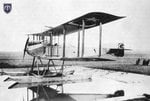The Turkish Air Force has a vivid and honorable history. The Turkish military first encountered hostile military aircraft in 1911 when Italy invaded Libya, at that time part of the Ottoman Empire. Italian aircraft performed reconnaissance and bombing missions against the Ottoman Army. Ottoman forces, however, had the honor of being the first to force down a warplane and capture the pilot. Earlier that year, the Turkish Minister of War directed establishment of an aircraft commission in Istanbul. The first airfield was near Istanbul and is now Ataturk International Airport. Two hangars were built, and training on and purchase of French, German and British aircraft began.
The fledgling TAF saw action in the Balkan War in September 1912 to October 1913, with only 17 aircraft, which primarily flew reconnaissance. In 1914, the first U.S. aircraft, a Curtiss seaplane, was sold to Turkey. Soon, however, Europe would be embroiled in the Great War. At the beginning of the war, Turkey had only five aircraft and six pilots. With the help of German and Austrian allies, the TAF expanded to 450 aircraft, many piloted by Germans. At the war's end, Turkey had almost 100 pilots and 17 land-based and three seaplane companies of four aircraft each. During the conflict, Turkish and German pilots had considerable success, sinking several British ships in the Aegean and destroying numerous British, French and Russian aircraft. Following the Armistice, the Ottoman Empire was dismantled, and most of the Army, including the air forces, disarmed.
Western powers moved to occupy many of the regions of Anatolia. Mustafa Kemal, later known as Ataturk, rallied forces against the invaders. In 1919, at the beginning of the national struggle, the Turks had no aircraft. In March 1920, the TAF was reestablished when pilots and others met to assemble aircraft from smuggled parts. Soon there were 17 aircraft, a mixture of Albatros, Breguet, Fiat, De Havilland and Spad models, which made limited strikes and conducted reconnaissance. When the War of Independence ended in 1922, the Air Force had grown to a group consisting of companies at Izmir, Afyon and Bandirma. In 1928, an Air Ministry was established with three battalions raised to regiment level in 1932, and brigade level in 1939. The three main bases were Eskisehir, Diyarbakir and Izmir.
Before World War II, an aircraft factory was built to build American Curtiss Hawk fighters and Turkey purchased Polish PZL and French Morane fighter planes. The Turks also acquired a number of bombers - German Heinkels, British Blenheims and American Martins and Vultees. Turkey remained neutral until the final days of World War II. As a result, the TAF obtained aircraft from axis and allied powers. They even acquired a few American B24 bombers interned after forced landings following the Ploesti raid of 1943.
Due to expansion, the Air Force became an independent service in 1944. After the war, Turkey purchased surplus Spitfires, Mosquitoes and Beaufighters before the United States became a major supplier of modern aircraft. In 1946, after the "Truman Doctrine" was declared, the Joint American Mission for Aid to Turkey was established in Ankara. In 1948, Turkey received P-47, B-26 and C-47 aircraft with training, supply and maintenance systems. In 1951, Turkey entered the jet age with the F-84.
The fledgling TAF saw action in the Balkan War in September 1912 to October 1913, with only 17 aircraft, which primarily flew reconnaissance. In 1914, the first U.S. aircraft, a Curtiss seaplane, was sold to Turkey. Soon, however, Europe would be embroiled in the Great War. At the beginning of the war, Turkey had only five aircraft and six pilots. With the help of German and Austrian allies, the TAF expanded to 450 aircraft, many piloted by Germans. At the war's end, Turkey had almost 100 pilots and 17 land-based and three seaplane companies of four aircraft each. During the conflict, Turkish and German pilots had considerable success, sinking several British ships in the Aegean and destroying numerous British, French and Russian aircraft. Following the Armistice, the Ottoman Empire was dismantled, and most of the Army, including the air forces, disarmed.
Western powers moved to occupy many of the regions of Anatolia. Mustafa Kemal, later known as Ataturk, rallied forces against the invaders. In 1919, at the beginning of the national struggle, the Turks had no aircraft. In March 1920, the TAF was reestablished when pilots and others met to assemble aircraft from smuggled parts. Soon there were 17 aircraft, a mixture of Albatros, Breguet, Fiat, De Havilland and Spad models, which made limited strikes and conducted reconnaissance. When the War of Independence ended in 1922, the Air Force had grown to a group consisting of companies at Izmir, Afyon and Bandirma. In 1928, an Air Ministry was established with three battalions raised to regiment level in 1932, and brigade level in 1939. The three main bases were Eskisehir, Diyarbakir and Izmir.
Before World War II, an aircraft factory was built to build American Curtiss Hawk fighters and Turkey purchased Polish PZL and French Morane fighter planes. The Turks also acquired a number of bombers - German Heinkels, British Blenheims and American Martins and Vultees. Turkey remained neutral until the final days of World War II. As a result, the TAF obtained aircraft from axis and allied powers. They even acquired a few American B24 bombers interned after forced landings following the Ploesti raid of 1943.
Due to expansion, the Air Force became an independent service in 1944. After the war, Turkey purchased surplus Spitfires, Mosquitoes and Beaufighters before the United States became a major supplier of modern aircraft. In 1946, after the "Truman Doctrine" was declared, the Joint American Mission for Aid to Turkey was established in Ankara. In 1948, Turkey received P-47, B-26 and C-47 aircraft with training, supply and maintenance systems. In 1951, Turkey entered the jet age with the F-84.



















